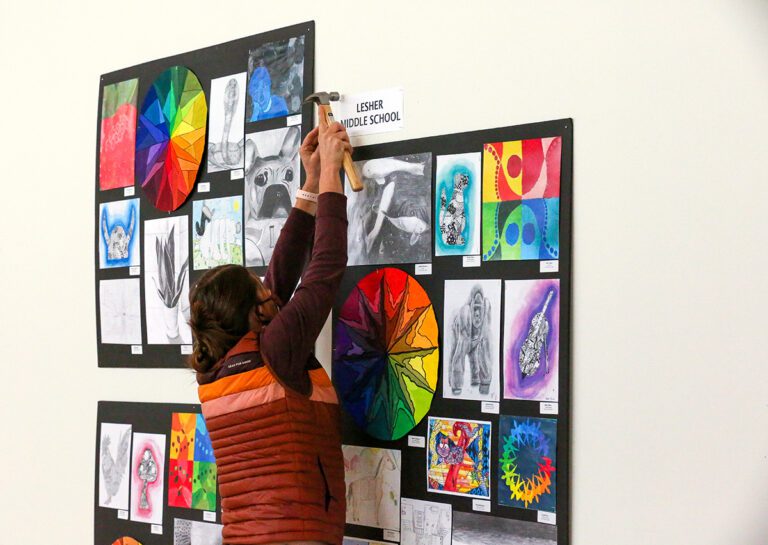Whether you’re a new teacher or seasoned veteran, applying healthy work-life habits is critical for long-term success as an art educator. Constantly pushing on the gas pedal can lead to burnout, resulting in feelings of frustration that could lead to a change of career. So how do you hit the pause button at work and make time for something else?
This question alone can sound counterintuitive and raise anxiety about your role in the building, status, and job security. There are, however, some quick things you can do to add balance to your life and support a long sustainable career in art education.
Here is a menu of options to help you manage your workload and add new activities into your life.

Disconnect from email.
Checking your school email in the evening and on weekends is largely unnecessary as most situations do not require an immediate response. The work will be there tomorrow. You also run the risk of receiving a negative email that impacts your mood. Knowing your school’s expectations with email is important. If it’s not communicated, twenty-four hours is a safe bet. Also, try disabling your phone’s push notifications, so you have to sync your email app manually as needed.
Stop grading everything.
The grading process takes up a lot of time and can be ineffective if you aren’t assessing specific skills and offering feedback that can be applied to future student work. Save time by eliminating grades for completion or participation. If you don’t think your students will do the work, check out this article, Can We Please Stop with the Participation Grades?.
Learn to say, “No” (politely).
Saying, “Yes,” to each request is an express pass to an overloaded plate. Saying, “No,” can be uncomfortable and tricky, but necessary for your survival. Be sure to decline in person or on the phone, so your tone is not misinterpreted in an email. Consider the potential impacts by saying, “No.” You can also share that you’re already at capacity and wouldn’t be able to commit the time and energy to devote to the task. Perhaps another time in the future would work better, or you can refer them to another contact.
Set short vs. long term goals.
Be manageable about your own expectations and remember that you can’t do everything right now. Bright flames burn quickly, and you want to last a whole career. Just be sure some of your short-term goals align with your supervisor, so you’re responsive to their expectations.
Make changes incrementally.
Making change over time is more sustainable than trying to accomplish too much in one year and exhausting yourself. This can also be a more effective approach with those impacted. Prioritize what is most critical and ripe for change and start there.
If you’re feeling consumed by home and work life, try creating a new aspect of your identity that connects to your interests and adds value to your life.
Here are 5 ideas.
1. Join a book club.

Reading with others promotes growth and learning with the benefit of socializing. Look for one that fits with your schedule or start your own.
2. Listen to podcasts.
If books aren’t your thing, podcasts are a great way to engage with thought-provoking material during convenient times like exercising or during travel time.
3. Make time to socialize.

Connecting with friends and family might sound like an obvious way to disconnect, but making it happen can sometimes be a challenge. Use a routine day or time (e.g., the first Friday of each month) to hold yourself accountable and help you and anyone else plan.
4. Start a blog.
There are ways to further engage professionally that are disconnected from your school. Try starting a blog or social media site to share teaching experiences and give back to the profession. Meeting others in your field and building your network can promote collaboration and provide you with a wealth of resources for the future.
5. Incorporate exercise.
Making time to focus on your own health and fitness is one of the most important things you can do in life. The professional benefits include more energy in the classroom and increased happiness from endorphins. Improved health also leads to fewer doctor appointments and illness, which means fewer sick days and sub plans. If the treadmill sounds miserable, try a gym class or local adult sports league.
A long and successful career as an art teacher is possible. Use these tips or check out our PRO Learning Pack dedicated to curbing art teacher burnout to help find the work-life balance you will need to stay passionate about teaching art.
What approaches have you found helpful to better manage your workload at school?
What are some other quick and easy activities for teachers to add to their life?
Magazine articles and podcasts are opinions of professional education contributors and do not necessarily represent the position of the Art of Education University (AOEU) or its academic offerings. Contributors use terms in the way they are most often talked about in the scope of their educational experiences.





